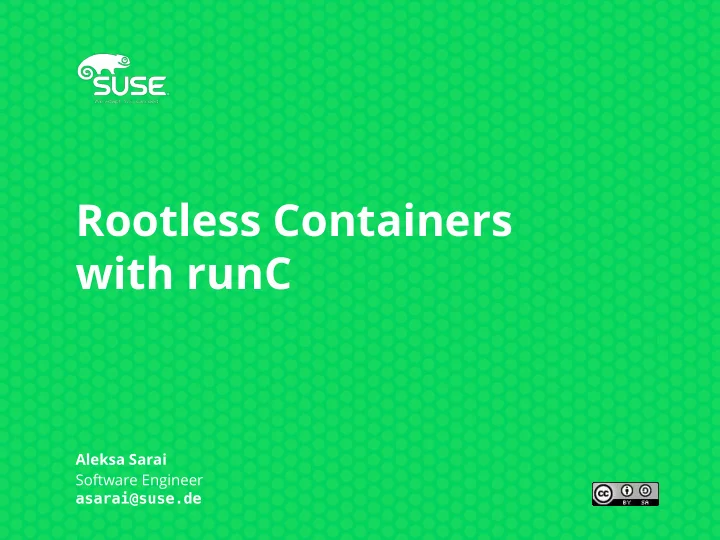

Rootless Containers with runC Aleksa Sarai Software Engineer asarai@suse.de
Who am I? Software Engineer at SUSE. ● Student at University of Sydney. ● Physics and Computer Science. – Maintainer of runC. ● Long-time Docker contributor and user. ● Free Software advocate. ● 2
The Problem Researcher wants to run some Python 3 code on a computing ● cluster. The cluster only supports Python 2. – So, researcher uses a container to package Python 3 – right? ● Drat! The administrator doesn’t want to install any new-fangled software. – The researcher tries to compile dependencies from scratch. ● Ha, ha. Don’t even get me started. – So, what should the researcher do? ● What if we could create and run containers without any privileges? – 3
What are Linux containers made of? Short answer: Namespaces. ● cgroups are not really required. – Long answer: A lot of duct tape, and some Linux Namespaces. ● They isolate a process’s view of parts of the system. ● Except the things that don’t have namespaces. Like the kernel keyring. – The most interesting of which is the user namespace. ● You can “pretend” that an unprivileged user is root. – 4
Unprivileged User Namespaces Since Linux 3.8, unprivileged users can create user namespaces. ● It’s been mostly safe* since Linux 3.19. – All other namespaces are pinned to a user namespace. ● You can create a fully namespaced environment without privileges! – Operations in the namespaces are more restricted than usual. – Only your user and group are mapped. ● 5
The Solution Get a container runtime to implement rootless containers. ● Disable features in the runtime until the container runs! – … or you can just do it manually: ● unshare -UrmunipCf bash – mount --make-rprivate / && mount --rbind rootfs/ rootfs/ – – mount -t proc proc rootfs/proc mount -t tmpfs tmpfs rootfs/dev – mount -t devpts -o newinstance devpts rootfs/dev/pts – – # ... skipping over a lot more mounting ... pivot_root rootfs/ rootfs/.pivot_root && cd / – mount --make-rprivate /.pivot_root && umount -l /.pivot_root – – exec bash # finally 6
What works? All basic functionality works with rootless containers. ● Working Broken run checkpoint [criu] exec restore [criu] kill pause [cgroups] delete resume [cgroups] list events [cgroups] state ps [cgroups] spec Detached containers [console] create start 7
Demo time! May the demo gods have mercy. 8
Consoles and runC Pseudo-TTY allocation is done using the host’s /dev/ptmx . ● This can break in user namespaces. – This is a long-standing bug in libcontainer. ● Responsible for breaking sudo in Docker for years. – We need this to run our integration tests, and for create / start. ● Solution: Do the allocation in the container and send a fjle ● descriptor over an AF_UNIX socket. 9
remainroot (1) Certain syscalls will always fail inside a rootless container. ● setuid (2) , setgid (2) , chown (2) , setgroups (2) , mknod (2) , etc. – Others will give confusing results. ● getgroups (2) , waitid (2) , etc. – Package managers and other tools can’t “drop privileges”. ● But we don’t have any privileges! – Solution: Write a tool to emulate GNU/Linux’s privilege model ● using ptrace (2) . Currently works for most things, needs some more shims. – https://github.com/cyphar/remainroot – 10
What about cgroups? cgroup access control is essentially a virtual fjlesystem. ● Everything under /sys/fs/cgroup is owned by root and has chmod go-w . – But most cgroupv1 controllers are hierarchical! ● And cgroupv2 is entirely hierarchical, by design. – So why don’t we have unprivileged subtree management? – We need cgroups for a lot of difgerent runC operations. ● Solution: Submit kernel patches that implement unprivileged ● subtree management. Submitted and rejected. – This would be useful for regular processes too (think Chromium). ● 11
Networking Unprivileged network namespaces aren’t useful. ● They only have a loopback interface. – To create a link to the host’s interface, you need CAP_NET_ADMIN in ● the host user namespace. Solution: Don’t unshare the network namespace – use the host’s . ● This means you don’t get to use iptables (8) .: – … but at least you get network access! – There’s some movement in the kernel to fjx this problem. ● 12
Other things left to do ps uses cgroups to get the list of processes in a container. ● Solution: More AF_UNIX socket magic. – checkpoint and restore are currently disabled. ● CRIU 2.0 has support for unprivileged checkpointing. – Not sure if it correctly checkpoints a rootless container. ● Unprivileged restore is on the roadmap. – Whilst cgroups are not generally solved, we can use them ● opportunistically. If we have write access to a controller, we should use it. – 13
Show me the code! Everything is in this pull request: opencontainers/runc#774 . ● Please help us test this! – Still needs some review and cleaning up. – “When will this be fjnished?” ● How many additional features do you need working? – 14
Questions? 15
Recommend
More recommend